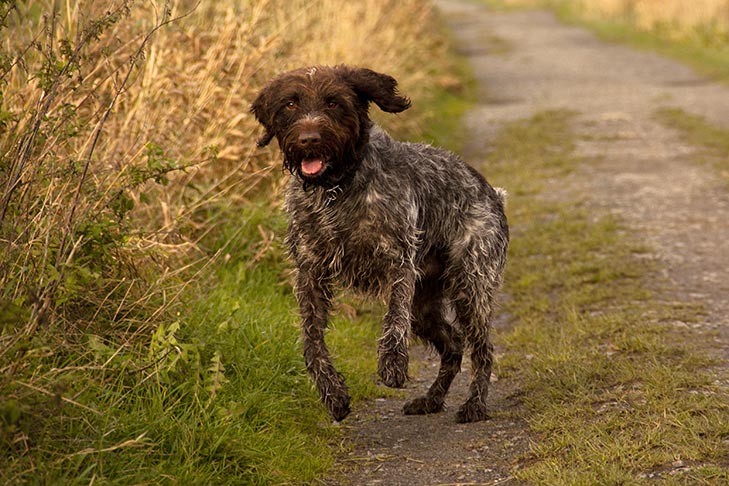
Depending on where you live, you may be familiar with a disease called valley fever in dogs. This fungal infection is commonly diagnosed in dogs and people and can lead to severe illness. Here’s what you need to know about Valley fever in dogs, including causes, symptoms, prevention, and treatment, to help keep yourself and your dog safe.
Like people, dogs can breathe in fungal spores without becoming ill. But, if your dog has a weakened immune system or comes in contact with a large number of spores, they can develop a respiratory infection with cough and fever. Senior dogs and puppies are more vulnerable to developing Valley fever because of their reduced immune response.
Although many animals, including fish and cattle, are susceptible to this disease, Valley fever is most commonly diagnosed in dogs and people. And, for some dogs, this organism can lead to severe illness. Given these risks and how common these fungi are, it’s important to know about Valley fever, including causes, symptoms, prevention, and treatment, to keep yourself and your dog safe.
What Is Valley Fever in Dogs? Is Valley Fever Contagious?
Valley fever is a dust-borne fungal infection. It’s caused by the fungus Coccidiodes, which is commonly found in the soil in areas like the southwestern United States (e.g., California, Arizona, Nevada, Utah, New Mexico, and Texas), as well as portions of Mexico, Central America, and South America. The fungus Coccidioides is generally found in the soil as a type of mold. When it rains, the fungus grows and produces infectious spores. These spores can spread when the soil is disturbed, such as when a dog digs in it, or when construction is occurring in the area.

Valley fever in dogs is also known as coccidioidomycosis or desert rheumatism. Valley fever is not contagious from person to person, from animal to animal, or between people and animals. So how do dogs contract Valley fever? As the wind picks up and the spores begin floating around in the air, your dog may inhale them. These fungal spores can affect the lungs, causing respiratory problems. Because dogs regularly sniff and claw at the ground when walking or playing, they tend to be more at risk for Valley fever than humans.
There are two forms of Valley fever: pulmonary and disseminated disease. Pulmonary coccidioidomycosis occurs when the infection is confined to the lungs. Disseminated coccidioidomycosis refers to when the disease has spread to other parts of the body, commonly leading to swelling of the joints and lameness.
Symptoms of Valley Fever in Dogs
Some dogs with Valley fever may show no signs of illness. However, many dogs will show signs of mild respiratory illness (or none at all) and recover uneventfully. In fact, about 70% of dogs who breathe in the Coccidioides fungus can deal with them easily, don’t show symptoms, and may develop immunity to the disease. How does this happen? A dog’s immune system may be able to recognize the proteins on the fungus’ surface, then fight off the infection.
For Valley fever in dogs, the incubation period (the time between exposure and symptoms appearing) is generally seven to 21 days. Symptoms will vary, depending on the severity of the disease. The more fungal spores a dog inhales, the more severe the infection will be, and the sicker the dog will become. Because Valley fever requires treatment with specific antifungal medications and can become fatal, it’s important to notify your veterinarian as soon as you notice symptoms.
Symptoms of Valley fever in dogs may include:
- Lethargy
- Coughing
- Fever
- Loss of appetite
- Weight loss
- Weakness or lameness
- Limping
- Neck or back pain
- Swollen lymph nodes (which help support your dog’s immune system)
- Abscesses (swollen skin filled with pus)
- Seizures
- Intermittent diarrhea

How Is Valley Fever Diagnosed in Dogs?
If your dog lives in an area where Valley Fever is endemic, your veterinarian may recommend routine testing, especially if your dog shows any signs of disease. If your dog has traveled to an area where Valley fever is common and shows symptoms, contact your veterinarian. Let them know your dog was recently in an area where Valley fever is common, so they can conduct appropriate tests and provide the right treatment.
Often, the veterinarian will conduct a laboratory test called a titer, which involves taking a blood sample from your dog. This test measures the level of antibodies (proteins produced by the immune system that attach to foreign bodies like fungi and remove them from the body) in your dog. Essentially, the titer can tell you whether your dog has been exposed to Coccidioides and whether their immune system is fighting off that infection. However, the results of the initial test may be negative, so repeat testing may be necessary three to four weeks later. The results of the titer test, along with other blood tests and X-ray images, can help your vet confirm whether your dog has Valley fever. Your vet may also collect fluid or tissue samples for inspection under a microscope.
Treatment of Valley Fever in Dogs
Once your vet has diagnosed your dog with Valley fever, they’ll prescribe an antifungal medication such as itraconazole or fluconazole. These medications get the fungal growth under control, so the dog’s immune system can be better prepared to fight infection.
Unfortunately, dogs who recover from Valley fever can suffer a relapse. So, the disease often requires long-term treatment, particularly if multiple organs are affected. Some dogs may need to be on medication for an extended period of time, sometimes up to one year.
For other dogs, Valley fever may require lifetime treatment to prevent relapses. In such cases, your veterinarian will need to conduct periodic blood testing because antifungal medications can affect the liver. Other antifungal medication side effects may include vomiting and loss of appetite. It’s a good idea to keep an eye on how your dog is responding to the antifungal medication. If the medication is working, you may see signs of improvement within weeks to a few months. Close monitoring and follow-up tests can help your vet decide if and when it’s appropriate to discontinue treatment. They may also prescribe anti-inflammatory medications or recommend dog supplements to support your immune, joint, and respiratory health.

How to Prevent Valley Fever in Dogs
If you live (or have traveled) in an area where Valley fever is common, and your dog develops symptoms, such as a dry cough or weight loss, seek veterinary care. If you reside in these areas, it’s important to limit your dog’s exposure to infectious spores. Keeping your dog indoors where possible a good idea.
Rather than exercising in outdoor areas, you may want to stick to paved sidewalks or train in an indoor facility. If you do go out into areas with a lot of dust, try to prevent your dog from digging or playing in the dirt. If there are heavy winds, make sure to keep your dog inside. This can help prevent them from inhaling dust and soil.

